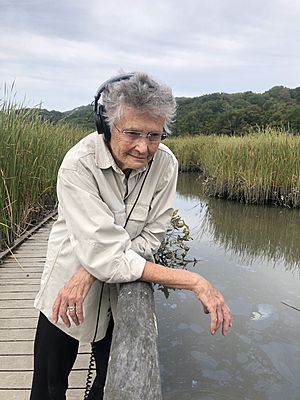Annea Lockwood facts for kids
Quick facts for kids
Annea Lockwood
|
|
|---|---|

Annea Lockwood in 2020
|
|
| Background information | |
| Born | July 29, 1939 Christchurch, New Zealand |
| Occupation(s) | Composer, academic musician |
Annea Lockwood was born on July 29, 1939, in Christchurch, New Zealand. She is a composer and a musician who taught at Vassar College. Annea is known for creating many different kinds of music. This includes electronic sounds and music made with voices. She also uses natural sounds that she records from the world around her. Some of her unique projects involved pianos that were burned or placed in water.
Contents
Early Life and Learning
Annea Lockwood studied how to compose music at the University of Canterbury in New Zealand. She earned a special degree there. After that, she continued her music studies in Europe. She learned from famous teachers like Peter Racine Fricker and Gottfried Michael Koenig. She also studied in the Netherlands. In 1964, Annea moved to London, England.
Creative Work and Music Style
In the late 1960s and early 1970s, Annea Lockwood performed and created music across Europe. She used unusual items in her music, like glass tubes. One famous piece was The Glass Concert (1967).
She also created a series called Piano Transplants. For these projects, she would burn, drown, or even plant pianos in different places. This was a way to explore new sounds and ideas.
In the 1970s, Annea started making music that was like performance art. This meant the audience and the environment became part of the music itself. She worked with dancers, poets, and visual artists.
Moving to New York and Nature Sounds
In 1973, Annea Lockwood moved to New York City. She began teaching at Hunter College. She became very interested in sounds from nature. She would record these sounds and use them to create new musical pieces.
- A Sound Map of the Hudson River (1982) used sounds from the famous Hudson River.
- World Rhythms (1975) explored sounds from different parts of the world.
Annea also created music based on conversations with people. Conversations with the Ancestors (1979) was made from talks with four women in their 80s. Delta Run (1982) was inspired by a conversation with a sculptor named Walter Wincha.
Unique Instruments and Collaborations
For her piece Three Short Stories and Apotheosis (1985), Annea used something she called the Soundball. This was a foam-covered ball with six small speakers and a radio receiver inside. She wanted to "put sound into the hands of the dancers." She also often uses the sounds of water in her compositions.
In the 1990s, Annea started writing music for both acoustic and electronic instruments. She also included multi-media and traditional instruments from different cultures. Thousand Year Dreaming (1991) used four didgeridoos. It also showed images from the Lascaux Cave during the performance.
In 2002, she began working on A Sound Map of the Danube River. For this, she recorded sounds from many places on, in, and around the Danube River.
Recognition and Teaching
Annea Lockwood's music has been featured at festivals all over the world. Her piece Piano Burning has been performed many times by others. It was even the last song on an album by the hip-hop group clipping. in 2019.
She received the Henry Cowell Award in 2007. She was also featured in two documentaries by Sam Green: Annea Lockwood / a Film About Listening (2021) and 32 Sounds (2022).
Annea Lockwood is now a professor emerita at Vassar College. She taught there since 1982.
Selected Music Recordings
Annea Lockwood's music has been released on many albums. Here are some of them:
- 1970: The Glass World of Anna Lockwood
- 1977: Tiger Balm
- 1989: A Sound Map of the Hudson River
- 1991: Night and Fog
- 1993: Thousand Year Dreaming
- 1997: The Glass World
- 1998: World Rhythms
- 1999: Breaking the Surface
- 2007: Thousand Year Dreaming/Floating World

